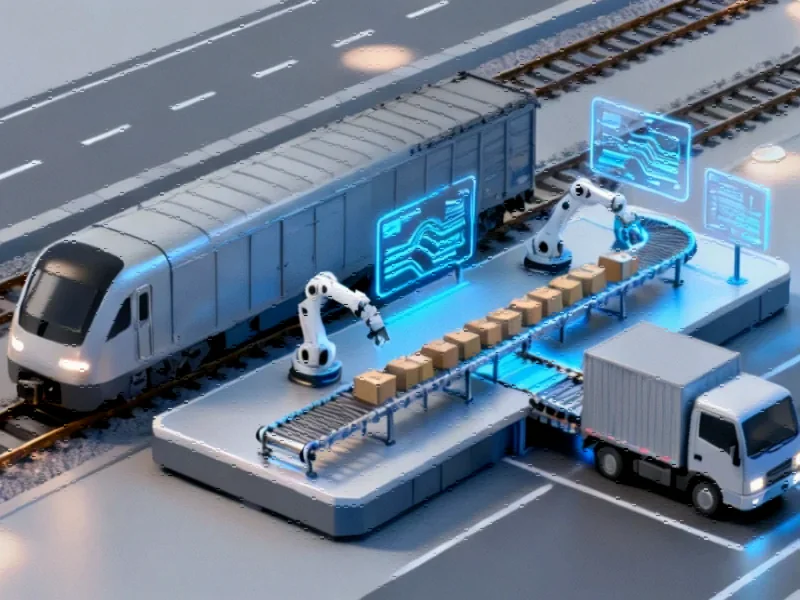Revolutionizing Intermodal Logistics
California-based startup Glīd Tech is reportedly developing a universal platform that enables frictionless transitions between rail and road transportation, according to industry reports. The company, founded in 2021 by CEO Kevin Damoa, aims to address longstanding inefficiencies in logistics operations, particularly for short-distance and small-batch shipments.
Sources indicate that traditional methods for transferring goods between transportation modes rely heavily on equipment like forklifts and cranes, creating significant delays and operational complexity. Glīd’s approach combines specialized hardware, advanced software, and physical AI systems to streamline these processes.
The Rāden Platform: Technical Innovation
At the core of Glīd’s solution is the Rāden platform, described in reports as an autonomous hybrid-electric vehicle measuring approximately 8 feet wide, 22 feet long, and 4.5 feet high. The vehicle features a patented mechanism that enables dual-mode operation on both rail and road infrastructure.
Analysts suggest the platform’s unique capability stems from its omni-directional wheel system, where all wheels are independently actuated. This allows the vehicle to move in any direction without changing orientation, enabling precise positioning during rail engagement. The system reportedly achieves lateral movement through coordinated wheel rotation at angles that facilitate sideways or diagonal motion at low speeds of around 5 mph.
AI-Powered Control Systems
According to technical documentation, the Rāden operates in concert with EZRA-1SIX, Glīd’s AI-powered control platform. The system integrates multiple advanced technologies, including geospatial mapping using LiDAR, radar, and camera arrays that generate 3D surface maps with centimeter-level precision.
The artificial intelligence systems conduct continuous visual rail inspections, identifying track misalignments, wear, or debris. These capabilities are part of what industry observers describe as growing trends in autonomy applications across various sectors.
Pilot Programs and Early Adoption
Glīd is currently conducting pilot programs with several partners, including the Great Plains Industrial Park in Parsons, Kansas. The facility, managed by the Great Plains Development Authority, occupies a former Army base spanning 27 square miles with 26 miles of rail track.
Brad Reams, Director of Great Plains Industrial Park, reportedly views Glīd’s technology as an enabler for what he calls “purple collar autonomy” – supporting logistics workers like truck drivers, crane operators, and rail engineers with advanced automation tools.
Railway Partnership in Northern California
Another pilot program is underway with Mendocino Railway, a Class III railroad managing short-distance lines in rural Northern California. The railway, which includes the historic Skunk Train operating since 1885, sees potential in Glīd’s technology to maintain affordable transportation logistics for local businesses.
Robert Pinnoli, CEO of Mendocino Railway, emphasized the efficiency advantages of rail transport, noting that short-haul rail can move one ton of freight approximately 500 miles per gallon of diesel – roughly 50 times more efficient than truck transportation. Industry publication Railway Age has covered this partnership extensively.
Funding and Development Support
According to financial reports, Glīd recently closed a $3.1 million pre-seed funding round with participation from Draper U Ventures, Outlander VC, Antler, The Veteran Fund, and M1C. The company is also receiving development support through Newlab Detroit, a venture platform focused on hard-tech innovation.
Through Newlab’s Centropolis Accelerator program, Glīd is receiving mentorship and resources to validate product-market fit and demonstrate commercial traction. The 12-week program specializes in helping founders developing physical products and hardware-enabled solutions.
Industry Impact and Future Potential
Industry analysts suggest Glīd’s technology could address multiple stress points in the $1 trillion annual rail and road logistics business, including truck driver shortages, rail capacity under-utilization, and intermodal terminal bottlenecks. The company claims its solutions can reduce operating costs by more than 50% compared to conventional diesel trucks, with customer payback periods under 2.5 years.
As the logistics industry continues to evolve with recent technology developments, solutions like Glīd’s platform represent emerging approaches to longstanding transportation challenges. More information about the company’s technology and approach is available through their official website at Glīd Tech.
According to industry observers, the success of these pilot programs could signal a broader transformation in how businesses approach short-distance logistics, particularly as manufacturing continues to expand across various regions of the United States. These industry developments reflect ongoing innovation in transportation and supply chain management.
This article aggregates information from publicly available sources. All trademarks and copyrights belong to their respective owners.
Note: Featured image is for illustrative purposes only and does not represent any specific product, service, or entity mentioned in this article.


